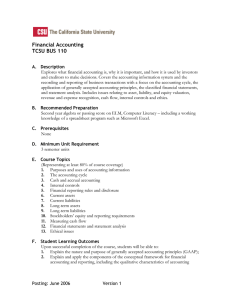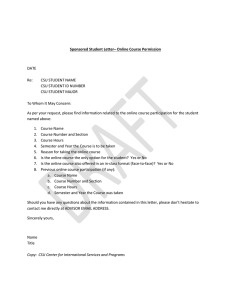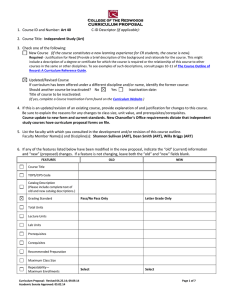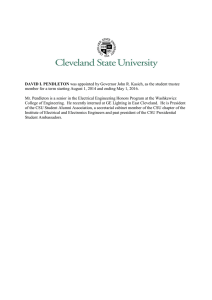BUS-1A (if applicable): Financial Accounting
advertisement
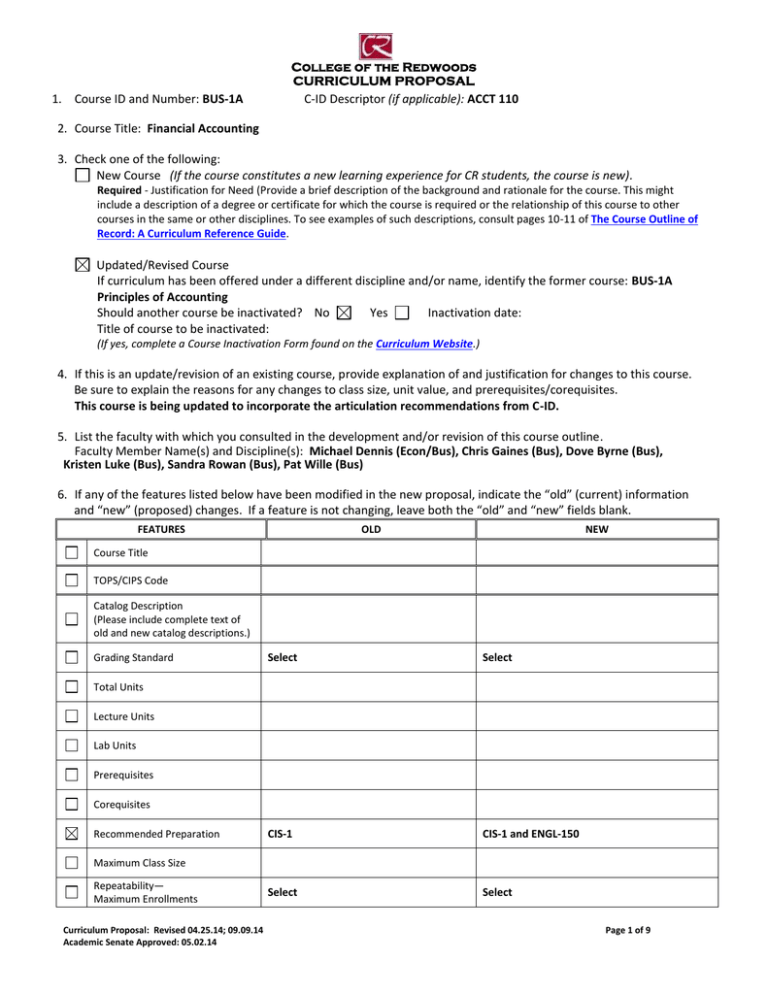
1. Course ID and Number: BUS-1A College of the Redwoods CURRICULUM PROPOSAL C-ID Descriptor (if applicable): ACCT 110 2. Course Title: Financial Accounting 3. Check one of the following: New Course (If the course constitutes a new learning experience for CR students, the course is new). Required - Justification for Need (Provide a brief description of the background and rationale for the course. This might include a description of a degree or certificate for which the course is required or the relationship of this course to other courses in the same or other disciplines. To see examples of such descriptions, consult pages 10-11 of The Course Outline of Record: A Curriculum Reference Guide. Updated/Revised Course If curriculum has been offered under a different discipline and/or name, identify the former course: BUS-1A Principles of Accounting Should another course be inactivated? No Yes Inactivation date: Title of course to be inactivated: (If yes, complete a Course Inactivation Form found on the Curriculum Website.) 4. If this is an update/revision of an existing course, provide explanation of and justification for changes to this course. Be sure to explain the reasons for any changes to class size, unit value, and prerequisites/corequisites. This course is being updated to incorporate the articulation recommendations from C-ID. 5. List the faculty with which you consulted in the development and/or revision of this course outline. Faculty Member Name(s) and Discipline(s): Michael Dennis (Econ/Bus), Chris Gaines (Bus), Dove Byrne (Bus), Kristen Luke (Bus), Sandra Rowan (Bus), Pat Wille (Bus) 6. If any of the features listed below have been modified in the new proposal, indicate the “old” (current) information and “new” (proposed) changes. If a feature is not changing, leave both the “old” and “new” fields blank. FEATURES OLD NEW Course Title TOPS/CIPS Code Catalog Description (Please include complete text of old and new catalog descriptions.) Grading Standard Select Select CIS-1 CIS-1 and ENGL-150 Select Select Total Units Lecture Units Lab Units Prerequisites Corequisites Recommended Preparation Maximum Class Size Repeatability— Maximum Enrollments Curriculum Proposal: Revised 04.25.14; 09.09.14 Academic Senate Approved: 05.02.14 Page 1 of 9 New SLOs: 1. Explain the nature of current assets and related issues, including the measurement and reporting of cash and cash equivalents, receivables and bad debts, inventory and cost of goods sold as well as the valuation and reporting of current liabilities, estimated liabilities, and other contingencies. 2. Identify and illustrate issues relating to long-term asset acquisition, use, cost allocation, and disposal. 3. Distinguish between capital and revenue expenditures. 4. Identify and illustrate issues relating to long-term financing through debt and equity decisions, including issuance, valuation, and retirement of debt (using time value of money techniques), issuance and repurchase of capital stocks, and dividends. 5. Explain the importance of operating, investing and financing activities reported in the Statement of Cash Flows. Other Old SLOS: 1. Explain and apply Generally Accepted New Course Objectives: Accounting Principles (GAAP) and 1.Explain the nature and purpose of generally accepted acc International Financial Reporting constraints and limitations on accounting Standards (IFRS) using spreadhseets. information; 2.Distinguish between cash and accrual accounting, 2 Definebalance and usesheets, accounting income andstatements, business and statemen 3.Construct and analyze transactions records, terminology; internal controls, financial statements, and financial rati 4. Identify the ethical implications in 3.Explain what a system is and how an accounting system financial reporting and apply strategies 4.Apply transaction analysis, input transactions into the ac for addressing them. 5.Distinguish between cash basis and accrual basis accoun 6.Identify and illustrate how the principles of internal cont Old outline did not include Course 7.Explain the content, form, and purpose of the basic finan Objectives. 8.Explain the nature of current assets and related issues, in 9. Explain the valuation and reporting of current liabilitie Old outline did not include Methods of 10. Identify and illustrate issues relating to long-term asse Instruction. 11. Distinguish between capital and revenue expenditures; 12.Identify and illustrate issues relating to long-term liabili 13.Identify and illustrate issues relating to stockholders’ eq 14.Explain the importance of operating, investing and finan 15.Interpret company activity, profitability, liquidity and so 16.Identify the ethical implications inherent in financial reporting and be able to apply strategies for addressing them. New Methods of Instruction: The instructor will provide an introduction to the material through lecture and readings. The instructor will provide students homework and in-class exercises to provide student an opportunity to apply the concepts from lecture and readings. The instructor will facilitate class discussions so that students can cement their understanding by exploring case studies with their classmates. Curriculum Proposal: Revised 04.25.14; 09.09.14 Academic Senate Approved: 05.02.14 Page 2 of 9 The instructor will provide exams to provide students an incentive to review and consolidate concepts and skills, then assess their performance based on their exam scores. 1. DATE: 1/27/2015 2. DIVISION: Career Technical Education 3. [CB04] COURSE CREDIT STATUS: D Credit-Degree Applicable 4. [CB01] COURSE ID AND NUMBER: BUS-1A 5. [CB02] COURSE TITLE: Financial Accounting (Course title appears in Catalog and schedule of classes.) 6. SHORT TITLE: Financial Accounting (Short title appears on student transcripts and is limited to 30 characters, including spaces.) 7. [CB03] LOCAL ID (TOPs code): 050200 Taxonomy of Program Codes 8. NATIONAL ID (CIP code): 520302 Classification of Instructional Program Codes 9. DISCIPLINE(S): Business Select from Minimum Qualifications for Faculty Course may fit more than one discipline; identify all that apply: Accounting, Finance, Small Business Development 10. FIRST TERM NEW OR REVISED COURSE MAY BE OFFERED: Fall 2015 11. COURSE UNITS (Note: 1 lecture unit requires 18 hours in-class/36 hours out-of-class; 1 lab unit requires 54 in-class hours) [CB07] TOTAL UNITS: TOTAL HOURS: [CB06] 4 4 min. units max. units 108 108 min. hours max. hours Lecture Units: 3 Lab Units: 1 Lecture Hours: 54 Lab Hours: 54 11. MAXIMUM CLASS SIZE: 55 12. WILL THIS COURSE HAVE AN INSTRUCTIONAL MATERIALS FEE? No Yes Fee: $ If yes, attach a completed Instructional Materials Fee Request Form found on the Curriculum Website. GRADING STANDARD Letter Grade Only Pass/No Pass Only [CB12] Is this course a repeatable lab course? No Grade-Pass/No Pass Option Yes Is this course to be offered as part of the Honors Program? No If yes, how many total enrollments? Select Yes If yes, explain how honors sections of the course are different from standard sections. CATALOG DESCRIPTION - The catalog description should clearly describe for students the scope of the course, its level, and what kinds of student goals the course is designed to fulfill. The catalog description should begin with a sentence fragment. A study of accounting as an information system, examining why it is important and how it is used by investors, creditors, and others to make decisions. The course covers the accounting information system, including recording and reporting of business transactions with a focus on the accounting cycle, the application of generally accepted accounting principles, the financial statements, and statement analysis. This course include issues relating to asset, liability, and equity valuation, revenue and expense recognition, cash flow, internal controls, and ethics. Special Notes or Advisories (e.g. Field Trips Required, Prior Admission to Special Program Required, etc.): Curriculum Proposal: Revised 04.25.14; 09.09.14 Academic Senate Approved: 05.02.14 Page 3 of 9 PREREQUISITE COURSE(S) No Yes Rationale for Prerequisite: Course(s): Math 380 Describe representative skills without which the student would be highly unlikely to succeed. Students are highly unlikely to succeed unless they are comfortable working with formulas and calculating percentages and ratios in a business setting. COREQUISITE COURSE(S) No Yes Rationale for Corequisite: Course(s): RECOMMENDED PREPARATION No Yes Course(s): CIS-1 and ENG-150 Rationale for Recommended Preparation: Course learning outcomes include use of spreadsheet programs. Students should be able to read college level textbooks and interpret precise instructions. COURSE LEARNING OUTCOMES –This section answers the question “what will students be able to do as a result of taking this course?” State some of the outcomes in terms of specific, measurable student actions (e.g. discuss, identify, describe, analyze, construct, compare, compose, display, report, select, etc.). For a more complete list of outcome verbs please see Public Folders>Curriculum>Help Folder>SLO Language Chart. Each outcome should be numbered. 1. Explain the nature of current assets and related issues, including the measurement and reporting of cash and cash equivalents, receivables and bad debts, inventory and cost of goods sold as well as the valuation and reporting of current liabilities, estimated liabilities, and other contingencies. 2. Identify and illustrate issues relating to long-term asset acquisition, use, cost allocation, and disposal. 3. Distinguish between capital and revenue expenditures. 4. Identify and illustrate issues relating to long-term financing through debt and equity decisions, including issuance, valuation, and retirement of debt (using time value of money techniques), issuance and repurchase of capital stocks, and dividends. 5. Explain the importance of operating, investing and financing activities reported in the Statement of Cash Flows. COURSE OBJECTIVES - This section describes the objectives the course addresses through the course content. Objectives can include specific disciplinary questions or goals that are central to the course subject matter and are meant to address what the various intents of the course are. Each objective should be numbered. 1. Explain the nature and purpose of generally accepted accounting principles (GAAP) and International Financial Reporting Standards (IFRS). Explain and apply the components of the conceptual framework for financial accounting and reporting, including the qualitative characteristics of accounting information, the assumptions underlying accounting, the basic principles of financial accounting, and the constraints and limitations on accounting information. 2. Define and use accounting and business terminology. 3. Explain what a system is and how an accounting system is designed to satisfy the needs of specific businesses and users; summarize the purpose of journals and ledgers. 4. Apply transaction analysis, input transactions into the accounting system, process this input, and prepare and interpret the four basic financial statements. 5. Distinguish between cash basis and accrual basis accounting and their impact on the financial statements, including the revenue recognition and matching principles. 6. Identify and illustrate how the principles of internal control are used to manage and control the firm’s resources and minimize risk. 7. Explain the content, form, and purpose of the basic financial statements (including footnotes) and the annual report, and how they satisfy the information needs of investors, creditors, and other users. 8. Explain the nature of current assets and related issues, including the measurement and reporting of cash and cash equivalents, receivables and bad debts, and inventory and cost of goods sold. 9. Explain the valuation and reporting of current liabilities, estimated liabilities, and other contingencies. 10. Identify and illustrate issues relating to long-term asset acquisition, use, cost allocation, and disposal. 11. Distinguish between capital and revenue expenditures. Curriculum Proposal: Revised 04.25.14; 09.09.14 Academic Senate Approved: 05.02.14 Page 4 of 9 12. Identify and illustrate issues relating to long-term liabilities, including issuance, valuation, and retirement of debt (including the time value of money.) 13. Identify and illustrate issues relating to stockholders’ equity, including issuance, repurchase of capital stock, and dividends. 14. Explain the importance of operating, investing and financing activities reported in the Statement of Cash Flows. 15. Interpret company activity, profitability, liquidity and solvency through selection and application of appropriate financial analysis tools. 16. Identify the ethical implications inherent in financial reporting and be able to apply strategies for addressing them. METHODS OF INSTRUCTION – Clear methods by which instructor will facilitate acquisition of objectives. Include here descriptions, NOT lists. Course outline must clearly articulate how these methods of instruction are related to, and help student work towards, achieving the objectives and student learning outcomes. Instructional methodologies will be consistent with, but will not be limited to, the following types orexamples. The instructor will provide an introduction to the material through lecture and readings. The instructor will provide students homework and in-class exercises to provide student an opportunity to apply the concepts from lecture and readings. The instructor will facilitate class discussions so that students can cement their understanding by exploring case studies with their classmates. The instructor will provide exams to provide students an incentive to review and consolidate concepts and skills, then assess their performance based on their exam scores. COURSE CONTENT–This section describes what the course is “about”-i.e. what it covers and what knowledge students will acquire. Concepts: What terms and ideas will students need to understand and be conversant with as they demonstrate course outcomes? Each concept should be numbered. 1. Purposes and uses of accounting information. 2. The accounting cycle. 3. Cash and accrual accounting. 4. Inventory methods, computation, and impact on financial statements. 5. Internal controls. 6. Financial reporting rules and disclosure, including international standards, such as International Financial Reporting Standards (IFRS). 7. Current assets. 8. Current liabilities. 9. Long-term assets. 10. Depreciation methods. 11. Long-term liabilities. 12. Stockholders’ equity and reporting requirements. 13. Measuring cash flow. 14. Financial statements and statement analysis. 15. Ratio analysis. 16. Ethical issues Issues: What primary tensions or problems inherent in the subject matter of the course will students engage? Each issue should be numbered. 1. Ethical decision making. Themes: What motifs, if any, are threaded throughout the course? Each theme should be numbered. 1. Business transactions and management decisions are expressed numerically as well as in words. 2. Consistent use of formats and terminology permits comparability between differing time periods and companies. 3. Successful analysis of financial data requires careful selection and application of such tools as ratios and trend information. 4. The need for ethics is critical, especially when making decisions and preparing reports. Skills: What abilities must students have in order to demonstrate course outcomes? (E.g. write clearly, use a scientific calculator, read college-level texts, create a field notebook, safely use power tools, etc). Each skill should be numbered. 1. Written and verbal presentation skills. Curriculum Proposal: Revised 04.25.14; 09.09.14 Academic Senate Approved: 05.02.14 Page 5 of 9 2. 3. 4. 5. 6. 7. Ethics in decision making. Teambuilding skills. Informational organization. Neatness and accuracy. Summarization and clarity in communications. Financial research. REPRESENTATIVE LEARNING ACTIVITIES –This section provides examples of things students may do to engage the course content (e.g., listening to lectures, participating in discussions and/or group activities, attending a field trip). These activities should relate directly to the Course Learning Outcomes. Each activity should be numbered. 1. 2. 3. 4. Listening to lectures. Working on in-class exercises. Completing homework exercises. Reading a textbook outside of class. ASSESSMENT TASKS –This section describes assessments instructors may use to allow students opportunities to provide evidence of achieving the Course Learning Outcomes. Each assessment should be numbered. Representative Assessment Tasks (These are examples of assessments instructors could use.): 1. Work in groups to complete problems and exercises. 2. Homework/project: Organize accounting data into financial statements and accounting reports. 3. Homework/project: Apply problem solving, critical thinking, and analytical skills to compare financial data over time, to competitors and within industries. 4. Homework/project: Conduct Internet research assignments. 5. Give oral presentations on research assignments or in-class exercises. Required Assessments for All Sections (These are assessments that are required of all instructors of all sections at all campuses/sites. Not all courses will have required assessments. Do not list here assessments that are listed as representative assessments above.): EXAMPLES OF APPROPRIATE TEXTS OR OTHER READINGS –This section lists example texts, not required texts. Author, Title, and Date Fields are required Author Kimmel, Weygandt, and Kieso Title Financing Accounting: Tools for Business Decision Making Date 2012 Author Wild Title Financial Accounting: Information for Decisions Date 2012 Author Williams, Haka, Bettner, and Carcello Title Financial Accounting Date 2011 Author Title Date Other Appropriate Readings: COURSE TYPES 1. Is the course part of a Chancellor’s Office approved CR Associate Degree? No Yes If yes, specify all program codes that apply. (Codes can be found in Outlook/Public Folders/All Public Folders/ Curriculum/Degree and Certificate Programs/choose appropriate catalog year): Required course for degree(s) AS General Business; ADT Business Restricted elective for degree (s) AALA Business Restricted electives are courses specifically listed (i.e. by name and number) as optional courses from which students may choose to complete a specific number of units required for an approved degree. 2. Is the course part of a Chancellor’s Office approved CR Certificate of Achievement? No Yes If yes, specify all program codes that apply. (Codes can be found in Outlook/Public Folders/All Public Folders/ Curriculum/Degree and Certificate Programs/choose appropriate catalog year): Required course for certificate(s) Small Business Management Restricted elective for certificate(s) Restricted electives are courses specifically listed (i.e. by name and number) as optional courses from which students may choose to complete a specific number of units required for an approved certificate. Curriculum Proposal: Revised 04.25.14; 09.09.14 Academic Senate Approved: 05.02.14 Page 6 of 9 3. [CB24] Is the course Stand Alone? No Yes (If “No” is checked for BOTH #1 & #2 above, the course is stand alone.) 4. [CB08] Basic Skills: NBS Not Basic Skills 5. [CB10] Work Experience: NWE Not Coop Work Experience 6. [CB22] Noncredit Category: Credit course, not applicable 7. Course eligible Career Technical Education funding (applies to vocational and tech-prep courses only): No 8. [CB23] Course developed using a Chancellor’s Office Economic Development Grant: No Yes Yes 9. [CB11] Purpose: Y Credit Course Course Classification Status 10. Accounting Method: W Weekly Census 11. [CB13] Disability Status: N Not a Special Class 12. [CB09] Course SAM Priority Code: D Possibly Occupational Definitions of SAM Priority Codes COURSE TRANSFERABILITY 1. [CB05] Current Transferability Status: A Transferable to both UC and CSU 2. [CB21] Course Prior to Transfer Level: Y Not Applicable Definitions of Course Prior to Transfer Levels CURRENT TRANSFERABILITY STATUS (Check at least one box below): This course is currently transferable to: Neither CSU nor UC CSU as general elective credit CSU as a specific course equivalent (see below) If the course transfers as a specific course equivalent give course number(s)/ title(s) of one or more currently-active, equivalent lower division courses from CSU. 1. Course ACCT 201, Campus CSU Chico 2. Course BA 250, Campus Humboldt State University UC as general elective credit UC as specific course equivalent If the course transfers as a specific course equivalent give course number(s)/ title(s) of one or more currently-active, equivalent lower division courses from UC. 1. Course MGT 11A, Campus UC Davis 2. Course , Campus PROPOSED CSU TRANSFERABILITY (Check at least one of the boxes below): No Proposal Remove as General Education Propose as General Elective Credit Propose as a Specific Course Equivalent (see below) If specific course equivalent credit is proposed, give course number(s)/ title(s) of one or more currently-active, equivalent lower division courses from CSU. 1. Course , Campus 2. Course , Campus PROPOSED UC TRANSFERABILITY (Check one of the boxes below): No Proposal Remove as General Education Propose as General Elective Credit OR Specific Course Equivalent (fill in information below) If “General Elective Credit OR Specific Course Equivalent” box above is checked, give course number(s)/ title(s) of one or more Curriculum Proposal: Revised 04.25.14; 09.09.14 Academic Senate Approved: 05.02.14 Page 7 of 9 currently-active, equivalent lower division courses from UC. 1. Course , Campus 2. Course , Campus CURRENTLY APPROVED GENERAL EDUCATION (Check at least one box below): Not currently approved CR CR GE Category(-ies): Select GE Category, Secondary GE Category (if applicable) CSU CSU GE Category: IGETC IGETC Category: PROPOSED CR GENERAL EDUCATION (Check at least one box below): No Proposal Remove as General Education Review to maintain CR GE Status New GE Proposal ____ _Approved as CR GE by Curriculum Committee: _______ _ ____ _ Not Approved (DATE) ____ _ Approved to remove CR GE status CR GE Outcomes GE learning outcomes in Effective Communication, Critical Thinking, and Global Awareness must be addressed in all general education courses. o Effective Communications: Explain how the proposed GE course fulfills at least one of the CR GE outcomes in this category. o Critical Thinking: Explain how the proposed GE course fulfills at least one of the CR GE outcomes in this category. o Global Awareness: Explain how the proposed GE course fulfills at least one of the CR GE outcomes in this category. GE Criteria for Breadth and Generality GE courses should be broad and general in scope. Typically such courses are introductory-- not advanced or specialized—and the content encompasses a broad spectrum of knowledge within a given field of study. Explain how the proposed GE course fulfills GE criteria for breadth and generality. CR GE Area Designation Course Learning Outcomes and Course Content should provide evidence of appropriate GE Area Designation. Additional rationale for GE Area Designation (optional): Area A: Area B: Area C: Area D: Natural Science Social Science Humanities Language and Rationality D1: Writing D2: Oral Communications D3: Analytical Thinking Area E: Multicultural Understanding* *To be considered part of CR GE Area E, all courses must meet the following two conditions: 1. The course must also be (or be proposed) in one other CR GE area AND 2. The course must be articulated with HSU as meeting their lower-division Diversity and Common Ground GE requirement. PROPOSED CSU GENERAL EDUCATION BREADTH (CSU GE) (Check at least one box below): NO PROPOSAL A. Communications and Critical Thinking A1 – Oral Communication A2 – Written Communication Curriculum Committee Approved: 04.25.14; 09.01.14 Academic Senate Approved: 05.02.14 B. Science and Math B1 – Physical Science B2 – Life Science Page 8 of 9 A3 – Critical Thinking B3 – Laboratory Activity B4 – Mathematics/Quantitative Reasoning C. Arts, Literature, Philosophy, and Foreign Language C1 – Arts (Art, Dance, Music, Theater) C2 – Humanities (Literature, Philosophy, Foreign Language) D. Social, Political, and Economic Institutions D0 – Sociology and Criminology D1 – Anthropology and Archeology D2 – Economics D3 – Ethnic Studies D5 – Geography D6 – History E. Lifelong Understanding and Self-Development D7 – Interdisciplinary Social or Behavioral Science E1 – Lifelong Understanding D8 – Political Science, Government and Legal Institutions E2 – Self-Development D9 – Psychology Rationale for inclusion in this General Education category: Same as above Proposed Intersegmental General Education Transfer Curriculum (IGETC) (Check at least one box below): NO PROPOSAL 1A – English Composition 1B – Critical Thinking-English Composition 1C – Oral Communication (CSU requirement only) 2A – Math 3A – Arts 3B – Humanities 4A – Anthropology and Archaeology 4B – Economics 4E – Geography 4F – History 4G – Interdisciplinary, Social & Behavioral Sciences 4H – Political Science, Government & Legal Institutions 4I – Psychology 4J – Sociology & Criminology 5A – Physical Science 5B – Biological Science 6A – Languages Other Than English Rationale for inclusion in this General Education category: Same as Above Submitted By: Michael Dennis Tel. Ext.: 4367 Dean/Director: Marla Gleave Date: 1/27/2015 Review Date: 2.2.15 For Dean/Director only: Does this course change require a substantial or nonsubstantial change to a degree? Yes CURRICULUM COMMITTEE USE ONLY Approved by Curriculum Committee: No Yes Date: 02.13.15 Academic Senate Approval Date: 02/20/15 Board of Trustees Approval Date: Curriculum Committee Approved: 04.25.14; 09.01.14 Academic Senate Approved: 05.02.14 Page 9 of 9 No
